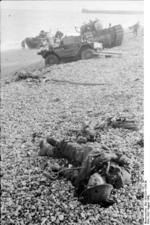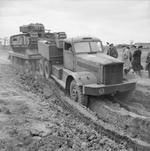Infantry Mk IV Churchill
| Country | United Kingdom |
| Manufacturer | Vauxhall Motors Ltd., Luton, Bedfordshire, England |
| Primary Role | Infantry Tank |
Contributor: C. Peter Chen
ww2dbaseThe Churchill tanks, formally designated as "Tank, Infantry, Mk IV (A22)", were an evolution of the infantry tank design that stressed on having heavily armored vehicles to support troops for trench warfare. The parent design, A20, was abandoned in 1940 after witnessing the German conquest of France, and a newly reworked A22 design was submitted in its place in Jun 1940. With the need to replace lost vehicles in the French campaign, the United Kingdom War Office accepted the new design almost immediately, requesting that it would enter production within a year. In Jul 1940, the design was finalized, and the first prototypes were built in Dec. Production began in Jun 1941.
ww2dbaseBecause Churchill tanks were designed to support infantry and not necessarily to battle other tanks, they were heavily armored with flat plates, which were not designed to deflect high-velocity tank gun rounds. The armor plates were bolted on and later welded. They had 11 bogies on each side, each carrying two 10-inch wheels; the great number of wheels meant that they could actually operate nearly normally even when some of the wheels became damaged in combat. They were the first tanks to be equipped with Merritt-Brown gearboxes, which allowed them to be steered by changing the relative speeds of the two tracks. They were each equipped with a light 2-pounder gun against enemy vehicles and a 3-inch howitzer to support the infantry.
ww2dbaseInitially, Churchill tanks were plagued with mechanical issues. The biggest problem was that the engines used was underpowered and unreliable, and the placement of the engines were so poor that crews found it difficult to access the engines for servicing. Some of the issues were address by the Churchill Mk III variant, introduced in Mar 1942, saving it from being discontinued in favor of the new Cromwell tanks. Among the improvements was the addition of the 57-millimeter 6-pounder gun, which was a vast improvement over the weak armaments as originally designed due to the role as infantry tanks. Most of the Churchill tanks built were of the Mk IV variant; the biggest change of this variant compared to the earlier tanks was the return to the cheaper-to-produce cast turrets. In 1944, the Mk VII variant entered combat on continental Europe; their 75-millimeter tank guns and even thicker (albeit still flat) armor made them powerful tanks, although since their engines were never upgraded since the start, mechanical troubles with the engines were still frequent. As infantry tanks, they were designed to be tough, as they were responsible to cross trenches and push away infantry obstacles such as barbed wires; as such, they were ideal candidates for jungle warfare in the South Pacific (though only a few were employed there by Australians) and as specialist vehicles (recovery vehicle, bridge-laying vehicle, "Hobart's Funnies", etc.).
ww2dbaseRussia received 301 Churchill Mk III and Mk IV tanks as part of the Lend-Lease Program.
ww2dbaseAfter the war, Churchill tanks remained in service as combat vehicles in the United Kingdom until 1952. One bridge-laying vehicle remained in service into the 1970s.
ww2dbaseIn 1948, Ireland rented four Churchill Mk VI tanks from the UK War Office for experimental reasons. They were purchased by Ireland in 1954. Three of them were inactivated before 1967, and the last one was inactivated in 1969.
ww2dbaseSource: Wikipedia.
Last Major Revision: Dec 2009
SPECIFICATIONS
Churchill I
| Machinery | One Bedford twin-six gasoline engine rated at 350hp |
| Suspension | Coiled spring |
| Armament | 1x40mm QF 2pdr gun (150 rounds), 1x3in howitzer (58 rounds), 1x7.92mm coaxial Besa machine gun |
| Armor | 16-102mm |
| Crew | 5 |
| Length | 7.30 m |
| Width | 3.00 m |
| Height | 2.80 m |
| Weight | 38.0 t |
| Speed | 24 km/h |
| Range | 90 km |
Churchill III
| Machinery | One Bedford twin-six gasoline engine rated at 350hp |
| Suspension | Coiled spring |
| Armament | 1x57mm QF 6pdr gun (84 rounds) in welded turret, 1x7.92mm coaxial Besa machine gun |
| Armor | 16-102mm |
| Crew | 5 |
| Length | 7.30 m |
| Width | 3.00 m |
| Height | 2.80 m |
| Weight | 38.0 t |
| Speed | 24 km/h |
| Range | 90 km |
Churchill IV
| Machinery | One Bedford twin-six gasoline engine rated at 350hp |
| Suspension | Coiled spring |
| Armament | 1x57mm QF 6pdr gun (84 rounds), 1x7.92mm coaxial Besa machine gun |
| Armor | 16-102mm |
| Crew | 5 |
| Length | 7.30 m |
| Width | 3.00 m |
| Height | 2.80 m |
| Weight | 38.0 t |
| Speed | 24 km/h |
| Range | 90 km |
Churchill V
| Machinery | One Bedford twin-six gasoline engine rated at 350hp |
| Suspension | Coiled spring |
| Armament | 1x95mm howitzer (47 rounds), 1x7.92mm Besa machine gun |
| Armor | 16-102mm |
| Crew | 5 |
| Length | 7.30 m |
| Width | 3.00 m |
| Height | 2.80 m |
| Weight | 38.0 t |
| Speed | 24 km/h |
| Range | 90 km |
Churchill VI
| Machinery | One Bedford twin-six gasoline engine rated at 350hp |
| Suspension | Coiled spring |
| Armament | 1x75mm Mk V gun, 1x7.92mm Besa machine gun |
| Armor | 16-102mm |
| Crew | 5 |
| Length | 7.30 m |
| Width | 3.00 m |
| Height | 2.80 m |
| Weight | 38.0 t |
| Speed | 24 km/h |
| Range | 90 km |
Churchill VII
| Machinery | One Bedford twin-six gasoline engine rated at 350hp |
| Suspension | Coiled spring |
| Armament | 1x75mm Mk V or Mk Va gun (84 rounds), 2x7.92mm Besa machine gun, 1x7.7mm Bren anti-aircraft machine gun, 1x2in |
| Armor | 16-152mm |
| Crew | 5 |
| Length | 7.54 m |
| Width | 3.25 m |
| Height | 2.49 m |
| Weight | 40.0 t |
| Speed | 24 km/h |
| Range | 90 km |
Churchill VIII
| Machinery | One Bedford twin-six gasoline engine rated at 350hp |
| Suspension | Coiled spring |
| Armament | 1x95mm howitzer (47 rounds), 1x7.92mm Besa machine gun |
| Armor | 16-102mm |
| Crew | 5 |
| Length | 7.30 m |
| Width | 3.00 m |
| Height | 2.80 m |
| Weight | 38.0 t |
| Speed | 24 km/h |
| Range | 90 km |
Churchill NA75
| Machinery | One Bedford twin-six gasoline engine rated at 350hp |
| Suspension | Coiled spring |
| Armament | 1x75mm gun (84 rounds; sometimes salvaged from damaged Sherman tanks), 1x7.92mm coaxial Besa machine gun |
| Armor | 16-102mm |
| Crew | 5 |
| Length | 7.30 m |
| Width | 3.00 m |
| Height | 2.80 m |
| Weight | 38.0 t |
| Speed | 24 km/h |
| Range | 90 km |
Churchill Crocodile
| Machinery | One Bedford twin-six gasoline engine rated at 350hp |
| Suspension | Coiled spring |
| Armament | Flamethrower; fuel towed in an armored wheeled trailer |
| Armor | 16-152mm |
| Crew | 5 |
| Length | 7.54 m |
| Width | 3.25 m |
| Height | 2.49 m |
| Weight | 40.0 t |
| Speed | 24 km/h |
| Range | 90 km |
Photographs
 |  |  |  |
Você gostou deste artigo ou achou este artigo útil? Se sim, considere nos apoiar no Patreon. Qualquer valor já vai ajudar! Obrigado. Por favor, ajude-nos a divulgar o site: Fique atualizado com WW2DB: |

- » Wreck of Teruzuki Found (27 jul 2025)
- » USS Orlean's Bow Found (22 jul 2025)
- » The Emperor of Japan Planned to Honor WW2-era Japanese POWs in Mongolia (4 jul 2025)
- » US State Lawmaker John Winter Caught Using Racial Slur "Jap" and Apologized (11 jun 2025)
- » US Government Plans to Purge WW2 Information (17 mar 2025)
- » Ver todas as notícias
 |
- » 1,182 biografias
- » 337 eventos
- » 45,132 entradas na linha do tempo
- » 1,249 navios
- » 350 modelos de aeronaves
- » 207 modelos de veículos
- » 376 modelos de armas
- » 123 documentos históricos
- » 261 instalações
- » 470 resenhas de livros
- » 28,430 fotos
- » 365 mapas
Winston Churchill
Por favor, considere nos apoiar no Patreon. Mesmo R$1 por mês já faz uma grande diferença. Obrigado!
Ou, por favor, nos apoie adquirindo alguns produtos do WW2DB na TeeSpring. Obrigado!